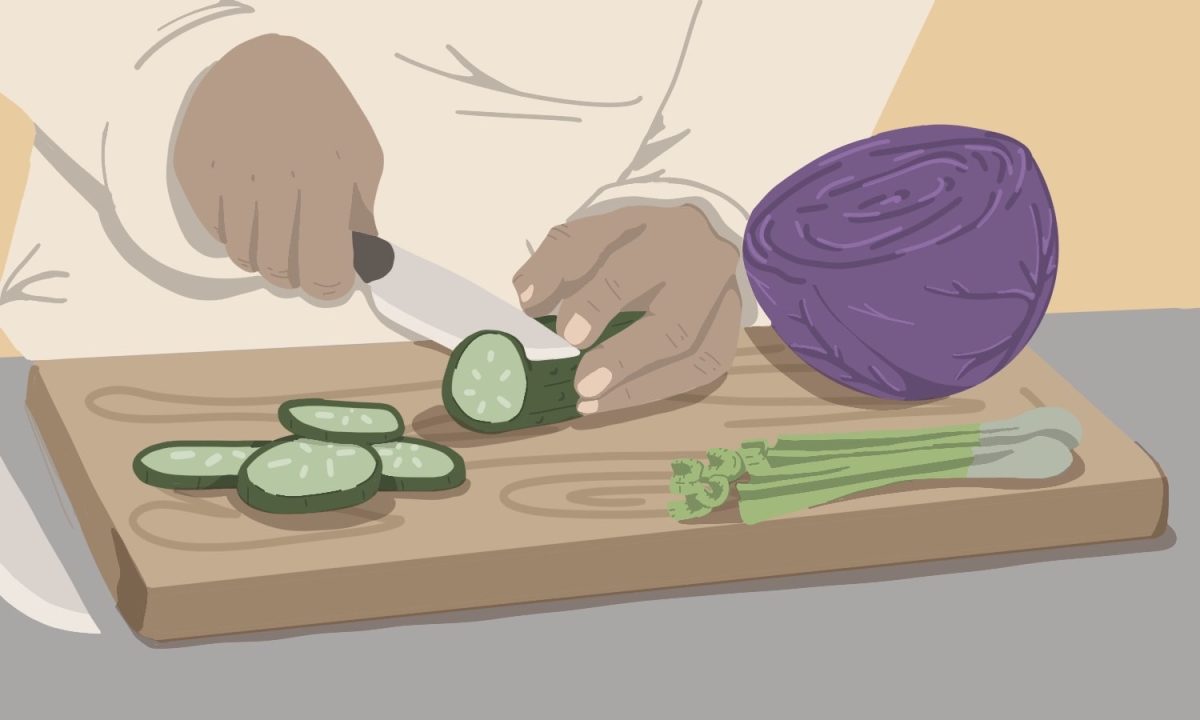For many, cooking at home can be a daunting task. What starts as cooking a nice meal inevitably leads to piles of dishes, unfortunate food waste and a result that never seems to live up to the expectations you had in your head.
However, by returning to the fundamentals of cooking, we allow ourselves to build upon these necessary skills, drastically improving the quality and ease of any recipe you set out to tackle.
Learn proper knife skills
There is perhaps no single technique more important to improving your home cooking than learning how to properly use a knife.
First, begin with a sharp knife. Mistakes happen, and any experienced cook will tell you how grateful they were that their knife was sharp when they cut themself. A dull knife requires significantly more force to cut, resulting in more severe injuries in the event of a slip.
For the beginner home cook, I recommend an 8-inch chef’s knife. This knife provides versatility, allowing you to tackle any recipe.
Second, focus on your grip. Never — I repeat, never — lay your hand flat on the cutting board. Turn the hand you will be holding the food with 90 degrees to the side, and assume a claw grip around the food. This way, rather than your entire finger sitting out ready to be chopped off, just the side of your knuckle will be exposed to the blade. Nothing ruins a recipe more than food covered in blood.
If you need a visual representation, this demonstration from the late Anthony Bourdain illustrates this concept perfectly.
Taste along the way
The first time you taste your dish should never be at the finish line.
If you’re making a full meal for yourself — for instance, aglio e olio with sauteed broccoli — the meal should be tasted as you move along. Taste the pasta when it nears al dente to check its doneness; taste your broccoli after it’s been seasoned; and taste your pasta once again after adding garlic and oil.
By doing this, you will gain a greater understanding of how to create flavorful dishes. If you taste the broccoli and find it bland, add some seasoning of your choice — maybe some salt or red chili flakes to bring in some new flavor profiles. If you taste the aglio e olio and find it overwhelming, experiment with adding some acidity, like freshly squeezed lemon, to balance out the flavors and add some pop.
While this all may seem confusing right now, the only way to develop that intuition is to taste as you go and experiment.
Clean as you go
There’s nothing worse than enjoying the meal you’ve just spent your valuable time making only to return to your kitchen and see a mountain of dirty dishes.
Especially as you start to explore more complex dishes, the number of pots, pans, utensils and extraneous containers necessary for you to dirty only seems to grow. As if that wasn’t enough, spilled sauce, food scraps and other random stains litter the kitchen, turning a 30-minute dinner into an hourlong cleanup.
Thankfully, a significant portion of this post-meal hassle can be avoided by cleaning as you go. While you wait for water to boil or a sauce to reduce, take that free time to grab a pot, pan or cutting board that’s no longer in use and give it a quick soapy scrub. If you’re so inclined, channel your inner Carmen “Carmy” Berzatto and throw a towel over your shoulder. Whenever some sauce spills over or your knife gets dirty, you can quickly clean it up before it dries and requires heavy scrubbing later.
Mise en place
It’s a tale as old as time: You buy all of the ingredients for your recipe from the store, start cooking and, right when you’re about to throw in one of your ingredients, you realize you’re not prepared. Maybe there was an onion that should’ve been diced or a combination of spices that should have been portioned out. Now your time window has passed, forcing you to continue without an ingredient or add it far too late and eat chunks of uncooked onion.
This whole situation can be avoided with the practice of mise en place — a French term loosely translated to “everything in its place.” Before you start cooking, take the time to portion out every ingredient you need. In this prep phase, you will also have time to focus on making precise, even cuts with your knife. Evenly chopped ingredients cook better and ensure every part of the dish reaches doneness at the same time.
It doesn’t matter the recipe length or ingredients — just make sure you are prepared before cooking, and it’ll make the whole job easier.
Stop asking how; ask why
If you want to transition from a novice home cook to someone ready to cook a dinner party for all your friends, stop looking at recipes only as instructions for how to make something.
Of course, a recipe is inherently a set of instructions. But beyond telling you how to make something, it also offers you an opportunity to ask why. This is where true culinary knowledge comes from.
At first, these answers may be difficult to come across. Allow yourself to simplify and perhaps ask, “Why does the recipe want me to take the pasta out one minute before it’s al dente?”
As you start to gain an understanding of these simpler answers, you can begin to ask questions that require fundamental knowledge. For example, if a recipe asks you to add soy sauce, ask yourself, “Why is umami flavor needed here?”
These answers will not only allow you to sound smarter at your dinner parties, but they will also aid you in making those quick, on-the-fly decisions while cooking.
Reach Will Engle at life@collegian.com or on Twitter @WillEngle44.










